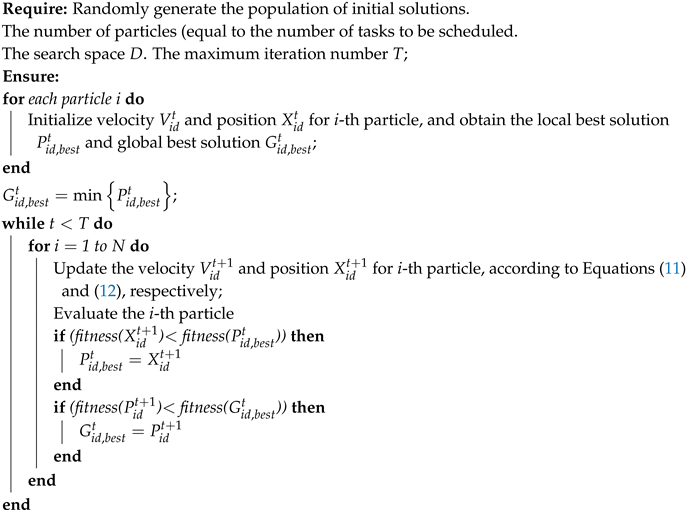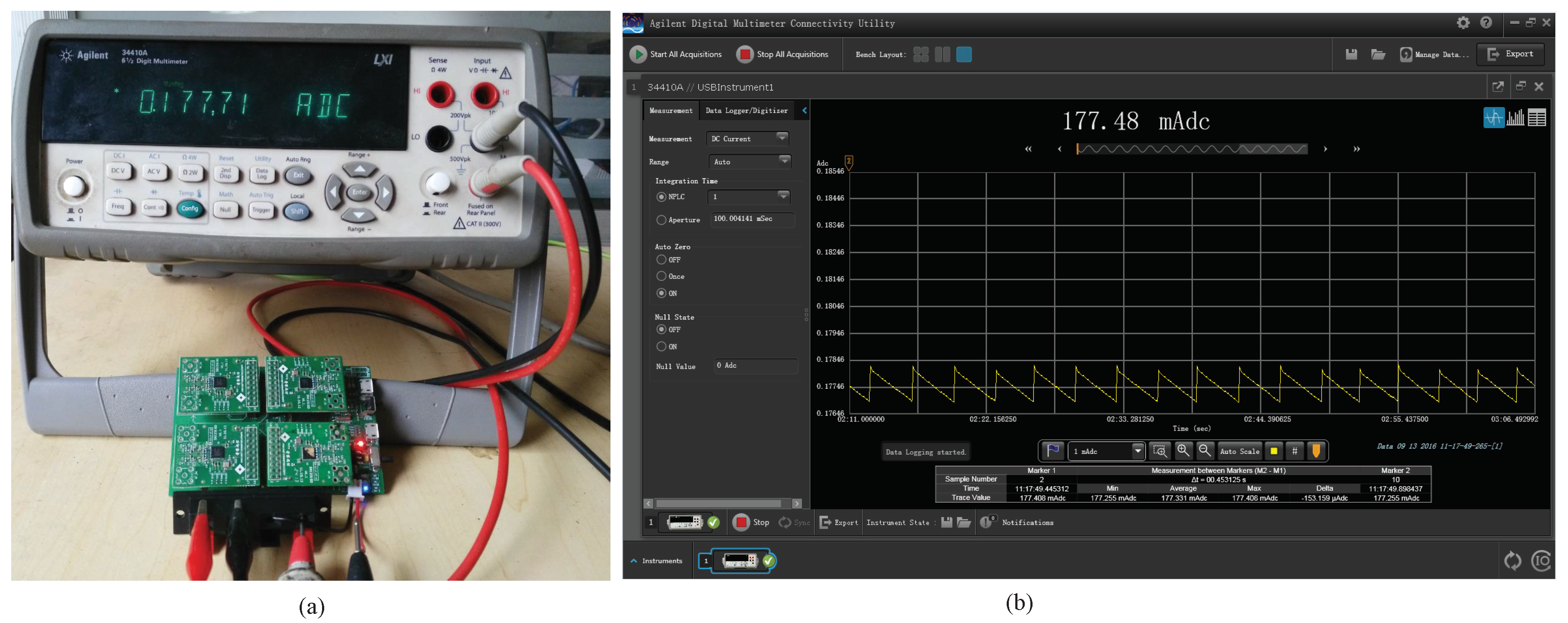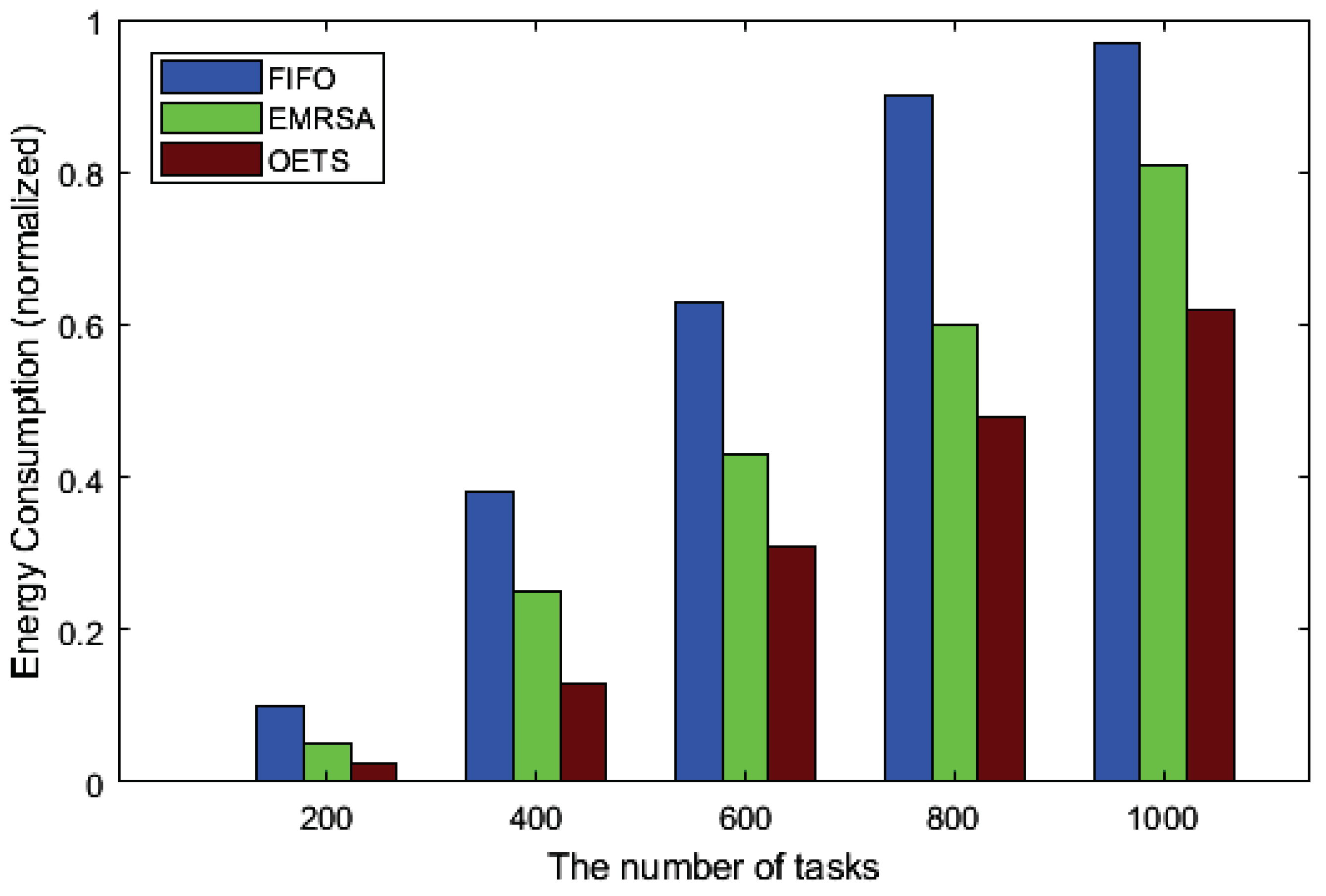Optimal Energy Consumption Tasks Scheduling Strategy for Multi-Radio WSNs
Abstract
:1. Introduction
- Analyzes the multi-task (typically the transmission task and idle listening task) scheduling process of multi-radio nodes. In our analysis, the tasks are divided into two sets, i.e., the waiting scheduling task set and the scheduled task set. In detail, the scheduled task set is further distinguished as transmitted packets and un-transmitted packets in order to obtain the accurate energy consumption model from the task scheduling perspective.
- Converts the energy consumption problem into a multi-task scheduling process and builds the accurate energy consumption model of MR-WSNs under the above two types of task status; obtains the optimization objective function and the corresponding constrained conditions of energy consumption for MR-WSNs. Hence, the energy consumption problem finally turns into an optimization problem with constraints.
- Introduces the PSO algorithm to solve the constrained optimization problem and designs the optimal energy consumption task scheduling strategy. Then provides the detailed key steps and pseudo-code of the optimization process. Meanwhile, the performance is also evaluated by experiments and simulations. Furthermore, the task extensibility of the proposed strategy is tested in order to confirm the optimal performance and the best number of tasks.
2. Related Work
3. Multi-Tasks Schedule Formulation and Energy Consumption Model
3.1. Multi-Task Schedule Description
3.2. Energy Consumption Model
4. Optimization Energy-Consumption Task Scheduling Strategy
4.1. Multi-Objective Optimization Model
4.2. Design of the Strategy
| Algorithm 1: The pseudo-code of the PSO used for MR-WSNs. |
 |
5. Performance Evaluation and Analysis
5.1. Experiment and Analysis
5.2. Simulation and Analysis
5.3. Tasks Extensibility Analysis
6. Conclusions
Author Contributions
Funding
Acknowledgments
Conflicts of Interest
References
- Aziz, A.A.; Sekercioglu, Y.A.; Fitzpatrick, P.; Ivanovich, M. A survey on distributed topology control techniques for extending the lifetime of battery powered wireless sensor networks. IEEE Commun. Surv. Tutor. 2012, 15, 121–144. [Google Scholar] [CrossRef]
- Ovsthus, K.; Kristensen, L.M. An industrial perspective on wireless sensor networks: A survey of requirements, protocols, and challenges. IEEE Commun. Surv. Tutor. 2014, 16, 1391–1412. [Google Scholar]
- Vazquez-Rodas, A.; Luis, J. A centrality-based topology control protocol for wireless mesh networks. Ad Hoc Netw. 2015, 24, 34–54. [Google Scholar] [CrossRef] [Green Version]
- Bagci, H.; Korpeoglu, I.; Yazıcı, A. A distributed fault-tolerant topology control algorithm for heterogeneous wireless sensor networks. IEEE Trans. Parallel Distrib. 2015, 26, 914–923. [Google Scholar] [CrossRef]
- Li, C.; Tang, M.; Zhang, G.; Wang, R.; Tian, C. A Hybrid Short-Term Building Electrical Load Forecasting Model Combining the Periodic Pattern, Fuzzy System, and Wavelet Transform. Int. J. Fuzzy Syst. 2020, 22, 156–171. [Google Scholar] [CrossRef]
- Al-Anbagi, I.; Erol-Kantarci, M.; Mouftah, H.T. A survey on cross-layer quality-of-service approaches in wsns for delay and reliability-aware applications. IEEE Commun. Surv. Tutor. 2016, 18, 525–552. [Google Scholar] [CrossRef]
- Peng, W.; Chen, D.; Sun, W.; Zhang, G. Distributed adaptive channel allocation in multi-radio wireless sensor networks. J. Commun. 2016, 11, 984–991. [Google Scholar] [CrossRef]
- Ren, Y.; Yuan, S.; Qiu, L.; Mei, H. Impact localization by a multi-radio sink-based wireless sensor network for large-scale structures. Adv. Struct. Eng. 2017, 20, 157–169. [Google Scholar] [CrossRef]
- Estevez, F.J.; Castillo-Secilla, J.M.; González, J.; Olivares, J.; Glosekotter, P. Mdaral: A multi-radio version for the daral routing algorithm. Sensors 2017, 17, 324. [Google Scholar] [CrossRef] [Green Version]
- Peng, W.; Chen, D.; Sun, W.; Li, C.; Zhang, G. Communication delay analysis under constrained condition for multi-radio WSNs. Adhoc Sens. Wirel. Netw. 2018, 42, 125–144. [Google Scholar]
- Zhang, D.; Zhu, Y.; Liu, S.; Zhang, X.; Song, J. Multi-Radio Multi-Channel (MRMC) resource optimization method for wireless mesh network. J. Inf. Sci. Eng. 2016, 32, 495–513. [Google Scholar]
- Li, J.; Guo, X.; Guo, L.; Ji, S.; Han, M.; Cai, Z. Optimal routing with scheduling and channel assignment in multi-power multi-radio wireless sensor networks. Ad Hoc Netw. 2015, 31, 45–62. [Google Scholar] [CrossRef]
- Chen, Z.; Li, Q.; Wu, L.; Cheng, S.; Lin, P. Optimal data collection of multi-radio multi-channel multi-power wireless sensor networks for structural monitoring applications: A simulation study. Struct. Control Health Monit. 2019, 26, e2328. [Google Scholar] [CrossRef]
- Surya, S.; Ravi, R. MPSO-SHM: Modified PSO based structural health monitoring system for detecting the faulty sensors in WSN. Wirel. Pers. Commun. 2019, 108, 141–157. [Google Scholar] [CrossRef]
- Elshrkawey, M.; Elsherif, S.M.; Wahed, M.E. An enhancement approach for reducing the energy consumption in wireless sensor networks. J. King Saud Univ. Comput. Inf. Sci. 2018, 30, 259–267. [Google Scholar] [CrossRef]
- Zhang, J.; Yin, J.; Xu, T.; Gao, Z.; Qi, H.; Yin, H. The optimal game model of energy consumption for nodes cooperation in WSN. J. Ambient Intell. Humaniz. Comput. 2018, 11, 589–599. [Google Scholar] [CrossRef]
- Hassan, E.S.; Elsafrawey, A.S.; Dessouky, M.I. Trade-off between self-healing and energy consumption in mobile unattended WSNs. IET Inf. Secur. 2018, 12, 285–292. [Google Scholar] [CrossRef]
- Tamandani, Y.K.; Bokhari, M.U.; Shallal, Q.M. Two-step fuzzy logic system to achieve energy efficiency and prolonging the lifetime of WSNs. Wirel. Netw. 2017, 23, 1889–1899. [Google Scholar] [CrossRef]
- Roselin, J.; Latha, P.; Benitta, S. Maximizing the wireless sensor networks lifetime through energy efficient connected coverage. Ad Hoc Netw. 2017, 62, 1–10. [Google Scholar] [CrossRef]
- Zhang, J.; Zhu, J.; Jia, Z.; Yan, X. A secret confusion based energy-saving and privacy-preserving data aggregation algorithm. Chin. J. Electrion. 2017, 26, 740–746. [Google Scholar] [CrossRef]
- Peng, W.; Chen, D.; Sun, W.; Li, C.; Zhang, G. Interval type-2 fuzzy logic based radio resource management in multi-radio WSNs. J. Intell. Fuzzy Syst. 2018, 35, 2525–2536. [Google Scholar] [CrossRef]
- Peng, W.; Chen, D.; Sun, W.; Li, C.; Zhang, G. Type-2 fuzzy logic based energy-efficient transceiver resource schedule in multi-radio WSNs. Int. J. Hoc Ubiquitous Comput. 2019, 32, 197–209. [Google Scholar] [CrossRef]
- Peng, W.; Chen, D.; Sun, W.; Li, C.; Zhang, G. Interval type-2 fuzzy logic based transmission power allocation strategy for lifetime maximization of WSNs. Eng. Appl. Artif. Intell. 2020, 87, 103269. [Google Scholar] [CrossRef]
- Dhami, M.; Garg, V.; Randhawa, N.S. Enhanced lifetime with less energy consumption in WSN using genetic algorithm based approach. In Proceedings of the 2018 IEEE 9th Annual Information Technology, Electronics and Mobile Communication Conference (IEMCON), Vancouver, BC, Canada, 1–3 November 2018. [Google Scholar]
- Sujatha, S.R.; Siddappa, M. Node localization method for wireless sensor networks based on hybrid optimization of particle swarm optimization and differential evolution. IOSR Comput. 2017, 19, 7–12. [Google Scholar] [CrossRef]
- Sujatha, S.R.; Siddappa, M. Self-adaptive differential evolution based localization of sensors in wireless sensor network. Int. J. Appl. Eng. Res. 2018, 13, 86–90. [Google Scholar]
- Cui, L.; Xu, C.; Li, G.; Ming, Z.; Feng, Y.; Lu, N. A high accurate localization algorithm with DV-Hop and differential evolution for wireless sensor network. Appl. Soft Comput. 2018, 68, 39–52. [Google Scholar] [CrossRef]
- Cespedes-Mota, A.; Castanon, G.; Martinez-Herrera, A.F.; Cardenas-Barron, L.E.; Sarmiento, A.M. Differential evolution algorithm applied to wireless sensor distribution on different geometric shapes with area and energy optimization. J. Netw. Comput. 2018, 119, 14–23. [Google Scholar] [CrossRef]
- Wan, Q.; Weng, M.J.; Liu, S. Optimization of wireless sensor networks based on differential evolution algorithm. Int. J. Online Eng. 2019, 15, 183–195. [Google Scholar] [CrossRef]
- Darji, H.; Shah, H.B. Genetic algorithm for energy harvesting-wireless sensor networks. In Proceedings of the 2016 IEEE International Conference on Recent Trends in Electronics, Information & Communication Technology (RTEICT), Bangalore, India, 20–21 May 2016. [Google Scholar]
- Yuan, X.; Elhoseny, M.; El-Minir, H.K.; Riad, A.M. A genetic algorithm-based, dynamic clustering method towards improved WSN longevity. J. Netw. Syst. Manag. 2017, 25, 21–46. [Google Scholar] [CrossRef]
- Wang, Z.J.; Zhan, Z.H.; Zhang, J. Solving the energy efficient coverage problem in wireless sensor networks: A distributed genetic algorithm approach with hierarchical fitness evaluation. Energies 2018, 11, 3526. [Google Scholar] [CrossRef] [Green Version]
- Hamidouche, R.; Aliouat, Z.; Gueroui, A.M. Genetic algorithm for improving the lifetime and QoS of wireless sensor networks. Wirel. Pers. Commun. 2018, 101, 2313–2348. [Google Scholar] [CrossRef]
- Panag, T.S.; Dhillon, J.S. A novel random transition based PSO algorithm to maximize the lifetime of wireless sensor networks. Wirel. Pers. Commun. 2018, 98, 2261–2290. [Google Scholar] [CrossRef]
- Singh, S.P.; Sharma, S.C. Implementation of a PSO based improved localization algorithm for wireless sensor networks. IETE J. Res. 2019, 65, 502–514. [Google Scholar] [CrossRef]
- Wang, J.; Gao, Y.; Liu, W.; Sangaiah, A.K.; Kim, H.J. An improved routing schema with special clustering using PSO algorithm for heterogeneous wireless sensor network. Sensors 2019, 19, 671. [Google Scholar] [CrossRef] [PubMed] [Green Version]
- Mukherjee, A.; Goswami, P.; Yan, Z.; Yang, L.; Rodrigues, J.J. ADAI and adaptive PSO-based resource allocation for wireless sensor networks. IEEE Access 2019, 7, 131163–131171. [Google Scholar] [CrossRef]
- Tukisi, T.W.; Mathaba, T.N.D.; Odhiambo, M.O. Multi-hop PSO based routing protocol for wireless sensor networks with energy harvesting. In Proceedings of the 2019 Conference on Information Communications Technology and Society (ICTAS), Durban, South Africa, 6–8 March 2019. [Google Scholar]
- Zhao, C.J.; Wu, H.R.; Liu, Q.; Zhu, L. Optimization strategy on coverage control in wireless sensor network based on Voronoi. J. Commun. 2013, 34, 115–122. [Google Scholar]







| Symbols | Description |
|---|---|
| m | the number of waiting to be scheduled tasks |
| n | the number of RF transceivers |
| the idle RF resource | |
| the i-th multi-radio node | |
| the j-th RF transceiver | |
| RF resource set | |
| waiting to be scheduled tasks set | |
| the l-th packets of | |
| the h packets allocated to | |
| the i-th task | |
| the q-th packet of | |
| required time for transmitting | |
| total time for transmitting | |
| the maximum between | |
| energy consumption of transmitting | |
| transmission power of | |
| total energy consumption of | |
| energy consumed for listening of | |
| idle listening power of | |
| total energy consumption of | |
| E | total energy consumption of |
| energy consumption of current solution | |
| energy consumption of new solution |
| Parameters | Value | Parameters | Value |
|---|---|---|---|
| No. of multi-radio node | 40 | Supply current | 3A DC |
| No. of RF transceivers (n) | 4 | Supply voltage | 3.3V DC |
| No. of tasks (m) | 200–1000 | Typical transmit energy consumption | 178 mA (17 dB) |
| No. of packets of each task (l) | 6 | Typical idle energy consumption | 2.25 mA (0 dB) |
| No. of Tasks | FIFO | EMRSA | OETS |
|---|---|---|---|
| 200 | 0.12 | 0.052 | 0.025 |
| 400 | 0.375 | 0.27 | 0.13 |
| 600 | 0.642 | 0.442 | 0.31 |
| 800 | 0.94 | 0.613 | 0.48 |
| 1000 | 0.98 | 0.807 | 0.62 |
| Parameters | Value | Parameters | Value |
|---|---|---|---|
| Network size | 100 × 100 m | No. of packets (each tasks) | 6 |
| No. of nodes | 120 | Energy model | Battery |
| No. of RF transceivers (n) | 4 | Data packet size | 64 Bytes |
| Node distribution | Uniform | Transmit power | Default |
| No. of tasks | 200–1000 | Idle listening power | Default |
© 2020 by the authors. Licensee MDPI, Basel, Switzerland. This article is an open access article distributed under the terms and conditions of the Creative Commons Attribution (CC BY) license (http://creativecommons.org/licenses/by/4.0/).
Share and Cite
Yan, Q.; Peng, W.; Zhang, G. Optimal Energy Consumption Tasks Scheduling Strategy for Multi-Radio WSNs. Sensors 2020, 20, 881. https://doi.org/10.3390/s20030881
Yan Q, Peng W, Zhang G. Optimal Energy Consumption Tasks Scheduling Strategy for Multi-Radio WSNs. Sensors. 2020; 20(3):881. https://doi.org/10.3390/s20030881
Chicago/Turabian StyleYan, Qiao, Wei Peng, and Guiqing Zhang. 2020. "Optimal Energy Consumption Tasks Scheduling Strategy for Multi-Radio WSNs" Sensors 20, no. 3: 881. https://doi.org/10.3390/s20030881





